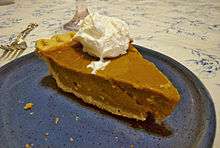Cool Whip
 | |
| Product type | Whipped topping |
|---|---|
| Owner | Kraft Heinz |
| Country | U.S. |
| Introduced | 1966 |
| Markets | Worldwide |
| Previous owners |
General Foods Kraft General Foods Kraft Foods |
| Website |
www |
Cool Whip is a brand of imitation whipped cream, referred to as whipped topping by its manufacturer. It is used in North America as a dessert topping and in some no-bake pie recipes. It was originally described as "non-dairy" as it contained neither cream nor milk and no lactose; however, it did contain the milk derivative caseinate. In 2010, both skimmed milk and light cream were added to Original Cool Whip.
Overview

Cool Whip was introduced in 1966 by the Birds Eye division of General Foods. Within two years of introduction, it became the largest and most profitable product in the Birds Eye line of products. General Foods later merged with Kraft Foods and Philip Morris, eventually becoming part of Altria Group until the spin-off of Kraft Foods from Altria in 2006. In July 2015, Kraft merged with Heinz to be known as the Kraft Heinz Company. Cool Whip is now the most eaten brand of whipped topping in the U.S.[1]
Cool Whip was created in 1966 by senior scientist Dr. William A. "Bill" Mitchell, a prolific food scientist at General Foods.[2] The key advantage of the invention was that it was a whipped cream-like product that could be distributed in a frozen state by grocery chains and kept in the consumer's refrigerator.
Cool Whip is manufactured in Avon, New York for the United States and Canadian markets.[3] It is sold in 8 oz. (226 g) and larger plastic tubs produced by Berry Plastics, is distributed through grocery outlets in a frozen state, and is refrigerated in the home prior to serving. Each nine gram serving provides 25 kcal (105 kJ) energy of which 1.5 g or 15 kcal (63 kJ) are fat.
The varieties currently sold are Original, Extra Creamy, French Vanilla, Light, Free (fat-free), and Sugar-Free (made with nutra sweet). Strawberry is sold seasonally, typically in the summer. French Vanilla and chocolate are also seasonal flavors, typically sold around Thanksgiving and Christmas. In fall 2011, a new flavor, cinnamon, was introduced along with French vanilla and chocolate. In Canada, the Fat-Free variety is labeled as Ultra-low Fat.
To date, Cool Whip is one of the most preferred whipped topping brands in the USA. A survey conducted in early 2015 across 24,000 American households evaluated consumption of whipped topping brands between 2011 and early 2015. The results determined that Cool Whip was the preferred whipped topping product, accounting for nearly 45% of respondents for all periods in the survey. Reddi-wip (whipped cream in an aerosol can) was a distant second in this survey, showing an 18% preference from survey respondents.[4]
Ingredients
Cool Whip Original is made of water, hydrogenated vegetable oil (including coconut and palm oils), high fructose corn syrup, corn syrup, skimmed milk, light cream, less than 2% sodium caseinate (a milk derivative), natural and artificial flavor, xanthan and guar gums, polysorbate 60, sorbitan monostearate, and beta carotene (as a coloring).[5] Only in Canada is Cool Whip produced and is available in an aerosol can using nitrous oxide as a propellant.
Cool Whip was formerly marketed as non-dairy, but in Jewish dietary traditions, Cool Whip was classified as dairy rather than parve (non-meat and non-dairy) because of the sodium caseinate (which is derived from milk). Cool Whip now contains milk and cream.
See also
- Dream Whip
- Non-dairy creamer, with similar ingredients
Notes
- ↑ "U.S.: Most eaten brands of whipped topping (cream type) 2011-2014". Retrieved 17 October 2014.
- ↑ Steyn, Mark (November 2004). "Tastemaker With a Sweet Tooth". The Atlantic.
- ↑ "Kraft Tells Schumer That Cool Whip Plant In Avon Is Unlikely To Close". senate.gov. Archived from the original on January 11, 2009.
- ↑ "U.S. households: Most eaten brands of whipped topping (cream type) from 2011 to 2015". statista.com. 2015.
- ↑ "Cool Whip". Kraft Foods. Retrieved 2008. Check date values in:
|access-date=(help)
References
- William Shurtleff, Akiko Aoyagi, Coffee Creamer, Cottage Cheese, and Icing/Frosting (1900-2013), Bibliography And Sourcebook, SoyInfo Center, 2013 PDF
External links
Further reading
- "Cool Whip: A delicious blend of sugar, wax, and condom lube". Wired. April 24, 2007.